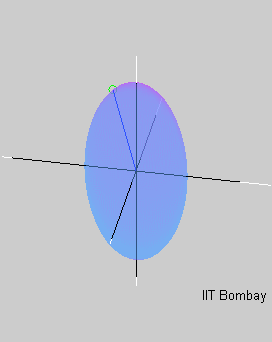Rotational
Motion of a Rigid Body under Internal Dissipation
The animation on this page depicts the rotational
motion of a rigid base body that is subject to some internal energy
dissipation. Possible mechanisms for energy dissipation are structural
damping in flexible appendages (such as antennae) and friction between
internal moving parts. Since the dissipation is due to internal forces,
the overall angular momentum remains the same. As a result,
the rotational state of the body gravitates from high kinetic energy
states to low kinetic energy states on the same anugular momentum level
set.
 The animation on the right shows the
angular momentum ellipsoid (not
the kinetic energy ellipsoid!) of the body. The principal geometrical
axes of the ellipsoid (shown by
white segments in all the animations) lie along the principal axes of
inertia of the body, with the longest geometrical axis along the minor
principal axis of inertia and the shortest along the major principal
axis of inertia. The white segments in the animations thus show the
instantaneous orientation of the principal axes frame of the body. The
black lines depict the (nonrotating) inertial reference frame for
comparison.
The animation on the right shows the
angular momentum ellipsoid (not
the kinetic energy ellipsoid!) of the body. The principal geometrical
axes of the ellipsoid (shown by
white segments in all the animations) lie along the principal axes of
inertia of the body, with the longest geometrical axis along the minor
principal axis of inertia and the shortest along the major principal
axis of inertia. The white segments in the animations thus show the
instantaneous orientation of the principal axes frame of the body. The
black lines depict the (nonrotating) inertial reference frame for
comparison.
The animation on the right shows the rotational
motion
that results when the initial angular velocity of the body is close to
its minor principal axis of inertia, which is also the longest
geometrical axis of the
ellipsoid. Since pure spin about the minor principal axis has the
greatest kinetic energy for a given angular momentum magnitude, the
initial kinetic energy in our simulation is close to the maximum
possible. The blue circle shows the tip of the angular velocity
vector which is depicted by the blue segment. A nonrotating observer
sees the angular velocity vector trace out the yellow herpolhode, while
an observer rotating with the body sees the angular velocity vector
trace out the red polhode. The polhode spirals onto the major principal
axis, the shortest geometrical axis of the ellipsoid. As kinetic energy
is dissipated, the major axis comes to rest while the ellipsoid itself
ends up spinning about the major principal axis. This is because pure
spin about the major axis represents the state with the least kinetic
energy for a given angular momentum.
The
animation appearing on this page was created with the help of Debashish
Bagg.
 The animation on the right shows the
angular momentum ellipsoid (not
the kinetic energy ellipsoid!) of the body. The principal geometrical
axes of the ellipsoid (shown by
white segments in all the animations) lie along the principal axes of
inertia of the body, with the longest geometrical axis along the minor
principal axis of inertia and the shortest along the major principal
axis of inertia. The white segments in the animations thus show the
instantaneous orientation of the principal axes frame of the body. The
black lines depict the (nonrotating) inertial reference frame for
comparison.
The animation on the right shows the
angular momentum ellipsoid (not
the kinetic energy ellipsoid!) of the body. The principal geometrical
axes of the ellipsoid (shown by
white segments in all the animations) lie along the principal axes of
inertia of the body, with the longest geometrical axis along the minor
principal axis of inertia and the shortest along the major principal
axis of inertia. The white segments in the animations thus show the
instantaneous orientation of the principal axes frame of the body. The
black lines depict the (nonrotating) inertial reference frame for
comparison. 